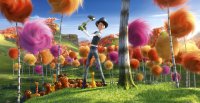Scaffolding Complex Topics in Middle School Social Studies
Children’s books and movies can help introduce topics like economic systems and make new material accessible for students.
Your content has been saved!
Go to My Saved Content.As a middle school social studies teacher, I’m always seeking new strategies and materials that will make my subject matter more accessible to my students. Like many other teachers, I often use fictional works—books and movies—to teach new or difficult or abstract concepts.
I have found children’s movies and literature particularly effective in illustrating historical concepts—though when using movies such as Mulan to teach ancient Chinese customs or The Butter Battle Book by Dr. Seuss to teach the Cold War, teachers do need to consider the historical accuracy of the materials presented. I often prefer using more unconventional works, ones that are less explicitly connected to the concept we’re studying.
Using Children’s Books and Movies to Simplify Difficult Concepts
Picture books can be a springboard to understanding historical concepts. They provide an oversimplification of a concept that can be applied by students to help them understand historical events.
For example, when we’re studying unionization and collective bargaining, I have my students analyze strikes. To help them get started, I use the picture book Click, Clack, Moo: Cows That Type, which was written by Doreen Cronin and illustrated by Betsy Lewin. I begin by defining the terms collective bargaining and grievances. After the students copy the definitions, I read Click, Clack, Moo, which is about cows that go on strike, demanding electric blankets.
We discuss what led the cows to strike, the farmer’s reaction to the strike, and what the strike accomplished. I have students identify labor (the cows), labor’s demands (electric blankets), management (Farmer Brown), and the negotiator (a duck). This gives students a framework for analyzing other strikes. When I later ask my students to think like historians and analyze historically important strikes, they ask themselves, “Who are the cows? Who is the farmer? And who is the duck?” A little silly, but memorable.
I use a similar strategy when I introduce the idea of Communism. Students may not understand it right off the bat, so I read The Rainbow Fish, which was written and illustrated by Marcus Pfister. It’s the story of a fish who shares his sparkly scales with other fish that don’t have shiny scales. The book illustrates a central tenet of Communism as written by Marx: “From each according to his ability, to each according to his needs.” The sparkly scales can represent wealth, which the rainbow fish shares with others according to their needs. At this point, my students are more prepared to discuss the philosophy of Communism.
Children’s movies can also give students a way in to understanding tough concepts. One might ask why I use children’s movies instead of historical dramas or documentaries, but it’s not an either/or situation—my students work with those materials as well. A children’s movie provides a change of pace and catches students’ attention. As with picture books, these movies also provide students with a simple springboard to understand historical concepts.
Click, Clack, Moo helps students understand how labor can organize and the potential effects of unions, and then we turn to the question of who might be opposed to workers organizing. As we get into the history of the sometimes violent attempts at union busting in the last century, we spot parallels in segments of the movie A Bug’s Life, in which a small group of grasshoppers take food collected by a larger group of ants. In one scene, the lead grasshopper yells to his crew, “You let one ant stand up to us, then they all might stand up! Those puny little ants outnumber us a hundred to one, and if they ever figure that out there goes our way of life.”
A Bug’s Life can also be used to introduce the history of sharecropping: The ants toil endlessly to meet the grasshoppers’ production quota and must survive on the little that is left, illustrating the relationship between landlords and sharecropping farmers. This is one of the great things about many children’s movies and books—they can often be used in many different contexts.
Many teachers use The Lorax to introduce concepts around environmentalism, but I also find it useful when teaching the period from the Industrial Revolution to the Gilded Age. Students may not immediately understand Cornelius Vanderbilt’s and John D. Rockefeller’s attempts to monopolize their respective industries, but the Once-ler chopping down all the Truffula trees to build his Thneed business gives us a starting point for discussion, and we move on to identify the conditions that led to the Industrial Revolution and then the rise of robber barons.
Why It Works
Using children’s literature and movies makes a lesson feel a little unpredictable for students and adds an element of fun. These works of art, while not obvious choices for classroom instruction at the middle school level, are powerful illustrations of historical concepts.
These works are filled with colorful images, talking animals, and fun stories that students are able to follow, preparing them to analyze and discuss more complex, real-world examples of similar ideas. Picture books and children’s movies provide students with appropriate scaffolding for their studies.
